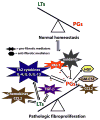Eicosanoid lipid mediators in fibrotic lung diseases: ready for prime time?
- PMID: 18574287
- PMCID: PMC2582216
- DOI: 10.1378/chest.08-0306
Eicosanoid lipid mediators in fibrotic lung diseases: ready for prime time?
Abstract
Recognition of a pivotal role for eicosanoids in both normal and pathologic fibroproliferation is long overdue. These lipid mediators have the ability to regulate all cell types and nearly all pathways relevant to fibrotic lung disorders. Abnormal fibroproliferation is characterized by an excess of profibrotic leukotrienes and a deficiency of antifibrotic prostaglandins. The relevance of an eicosanoid imbalance is pertinent to diseases involving the parenchymal, airway, and vascular compartments of the lung, and is supported by studies conducted both in humans and animal models. Given the lack of effective alternatives, and the existing and emerging options for therapeutic targeting of eicosanoids, such treatments are ready for prime time.
Conflict of interest statement
Dr. Peters-Golden declares no conflict of interest.
Dr. Huang declares no conflict of interest.
Figures


Similar articles
-
Eicosanoids: mediators and therapeutic targets in fibrotic lung disease.Clin Sci (Lond). 2005 Jun;108(6):479-91. doi: 10.1042/CS20050012. Clin Sci (Lond). 2005. PMID: 15896193 Review.
-
Lipids and eicosanoids in fibrosis: emerging targets for therapy.Curr Opin Rheumatol. 2012 Nov;24(6):649-55. doi: 10.1097/BOR.0b013e328356d9f6. Curr Opin Rheumatol. 2012. PMID: 22810365 Review.
-
Mechanisms of Disease: leukotrienes and lipoxins in scleroderma lung disease--insights and potential therapeutic implications.Nat Clin Pract Rheumatol. 2007 Jan;3(1):43-51. doi: 10.1038/ncprheum0375. Nat Clin Pract Rheumatol. 2007. PMID: 17203008 Review.
-
Lipid inflammatory mediators: leukotrienes, prostaglandins, platelet-activating factor.Clin Allergy Immunol. 2002;16:233-54. Clin Allergy Immunol. 2002. PMID: 11577541 Review.
-
[Eicosanoids as mediators in ARDS].Anasthesiol Intensivmed Notfallmed Schmerzther. 1994 Feb;29(1):3-9. doi: 10.1055/s-2007-996677. Anasthesiol Intensivmed Notfallmed Schmerzther. 1994. PMID: 8142566 Review. German.
Cited by
-
Eicosanoid regulation of hematopoiesis and hematopoietic stem and progenitor trafficking.Leukemia. 2010 Dec;24(12):1993-2002. doi: 10.1038/leu.2010.216. Epub 2010 Sep 30. Leukemia. 2010. PMID: 20882043 Free PMC article. Review.
-
Activity of the cyclooxygenase 2-prostaglandin-E prostanoid receptor pathway in mice exposed to house dust mite aeroallergens, and impact of exogenous prostaglandin E2.J Inflamm (Lond). 2009 Oct 30;6:30. doi: 10.1186/1476-9255-6-30. J Inflamm (Lond). 2009. PMID: 19878559 Free PMC article.
-
DROSHA-Dependent miRNA and AIM2 Inflammasome Activation in Idiopathic Pulmonary Fibrosis.Int J Mol Sci. 2020 Feb 28;21(5):1668. doi: 10.3390/ijms21051668. Int J Mol Sci. 2020. PMID: 32121297 Free PMC article. Review.
-
The Role of Immune and Inflammatory Cells in Idiopathic Pulmonary Fibrosis.Front Med (Lausanne). 2018 Mar 20;5:43. doi: 10.3389/fmed.2018.00043. eCollection 2018. Front Med (Lausanne). 2018. PMID: 29616220 Free PMC article. Review.
-
Lipidomics in Understanding Pathophysiology and Pharmacologic Effects in Inflammatory Diseases: Considerations for Drug Development.Metabolites. 2022 Apr 7;12(4):333. doi: 10.3390/metabo12040333. Metabolites. 2022. PMID: 35448520 Free PMC article. Review.
References
-
- Selman M, King TE, Pardo A. Idiopathic pulmonary fibrosis: prevailing and evolving hypotheses about its pathogenesis and implications for therapy. Ann Intern Med. 2001;134:136–151. - PubMed
-
- American Thoracic Society/European Respiratory Society International Multidisciplinary Consensus Classification of the Idiopathic Interstitial Pneumonias. This joint statement of the American Thoracic Society (ATS), and the European Respiratory Society (ERS) was adopted by the ATS board of directors, June 2001 and by the ERS Executive Committee, June 2001. Am J Respir Crit Care Med. 2002;165:277–304. - PubMed
-
- Funk CD. Prostaglandins and leukotrienes: advances in eicosanoid biology. Science. 2001;294:1871–1875. - PubMed
-
- Charbeneau RP, Peters-Golden M. Eicosanoids: mediators and therapeutic targets in fibrotic lung disease. Clin Sci (Lond) 2005;108:479–491. - PubMed
-
- Peters-Golden M, Henderson WR., Jr Leukotrienes. N Engl J Med. 2007;357:1841–1854. - PubMed
Publication types
MeSH terms
Substances
Grants and funding
LinkOut - more resources
Full Text Sources
Medical

